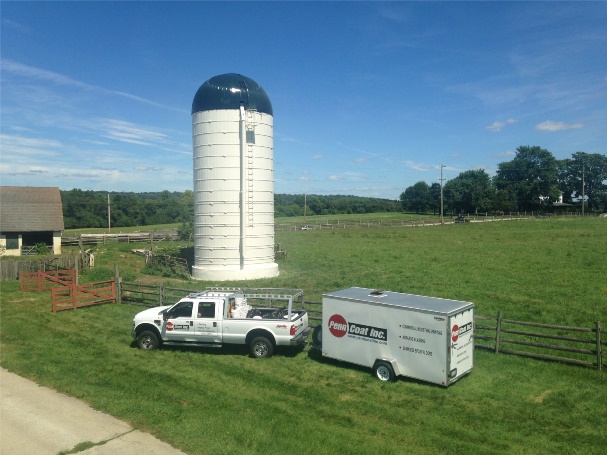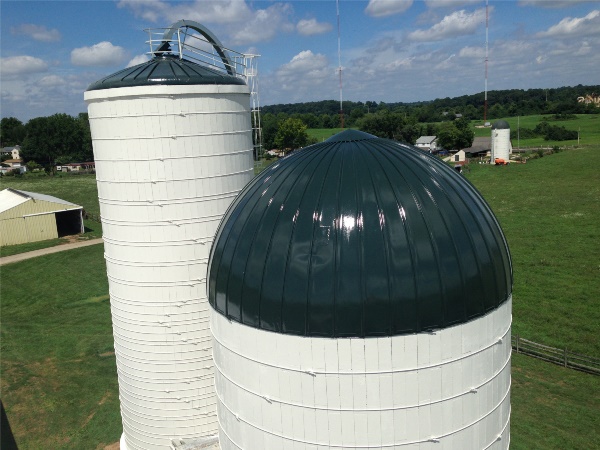Outside the Philadelphia city limits sits a conservation site called Whitemarsh Foundation. Inside the almost 180 acres (~728,000 m²) are buildings and livestock befitting a farm: cattle, barn swallows, and a farm house, to name a few. Three retired silos in the middle of a field called the PennCoat crew to the sanctuary.
Covered in moss and bird droppings, each of the concrete structures needed a facelift to look more visitor-friendly. Whitemarsh Foundation wanted a solution to the unsightly silos, and PennCoat was able to find it for them.
It’s Electric!
Over the course of a month, PennCoat’s four-person crew prepped and painted the three silos, all of which were identical in diameter and two of which were identical in height, as well.
Access to the field wasn’t difficult. The crew was able to mobilize to the site with their trailers via a gravel road. “You’re not driving through gopher holes or anything,” Jeff Neal, project manager/estimator for PennCoat said. But you might say the location did present a bit of an electrifying challenge.
The silos are located near a bull pen, which uses an electric perimeter fence to keep the cattle in. When they got to the first task of power washing the structures, they encountered a potentially dangerous situation. “We had to weave the hose through an electric fence, which was supposed to be turned off,” Neal said. Although the PennCoat crew had confirmed that the electricity was turned off, they found out the hard way that that wasn’t the case! “Even though the hose was rubberized, it was still going through and they were getting jolts through the power washing units,” Neal continued. Luckily, no one was seriously injured, but they knew they couldn’t continue with the power on. “He was able to turn it off for the two days that we needed it,” Neal explained of the facility manager.
Back in the saddle, the crew used 5,000 psi (34.5 MPa) power washers with hot water supplied by Water Cannon. Because they didn’t have any place to dispose of anything but pure water “outside in the middle of a farm,” as Neal explained, no detergents or degreasers were used. The crew also didn’t need hard hats, safety vests, or respirators during this stage of the project. “That’s only because of where it was,” Neal explained. “If it was in closed doors or proximity to other buildings, we would definitely have had them wear them [respirators].”
Rust Be Gone
Throughout the entire project, the PennCoat crew worked from lifts to reach all surfaces of the silos — from the ground to 35 and 54 feet (10.7 and 16.5 m) up in the air.
“The guys wore harnesses with lanyards, and they always locked into the lift for fall protection safety,” Neal said. “We make it mandatory that they wear safety glasses. Other than that, ’cause it was outside, no other PPE [personal protective equipment] was required.”

From the lifts, the crew first applied a clear material onto any rusted areas on the ladders and the cross-hatched cages encasing the silos. They brush applied the POR-15 on those metal areas to “prevent any rust from bleeding through the topcoat,” Neal said. Areas covered by that clear material and any other non-rusted metal areas, such as the domes, were to be covered by “a really dark grayish blue” coating. But first, the crew coated the concrete silos with a white silicone coating.
The crew applied Dow Corning’s AllGuard Silicone Elastomeric in two coats, each at approximately 10 mils (254.0 microns) dry film thickness (DFT). “Mostly with tanks, we can go in and brush and roll them, but with the ribbing we couldn’t,” Neal explained. Instead, they spray applied the coating onto the concrete with equipment from Graco.
Next, they covered the domes with PPG’s DURETHANE DTM Urethane Mastic. This coating was again applied in two coats but this time at approximately 4 mils (101.6 microns) each coat. “Because those are flat,” Neal said of the domes, “they were brush and rolled.”
Throughout the coating portion of the project, the crew kept an eye out for any storms. “We try to look out for the forecast, but it’s not always accurate. We try to look for at least a week of clear skies,” Neal explained. Although the crew did get some rain that halted the prep portion, they “were able to get all the coating done without any delays,” according to Neal. No electric interferences in the form of lightning at least!
Time After Time
True to his estimator title, Neal completes what he calls “time studies” of projects, including this one, which took 313 man hours to complete. He said that it “helps with planning, making sure we’re giving the customer accurate estimates.” If Neal over estimates the amount of time that it’ll take PennCoat to complete the job, it’s “not fair to the customer,” and if he underestimates the time needed, you’re “shooting yourself in the foot,” he explained. Keeping close records helps Neal keep track of how long each task takes, which helps him have a better understanding for future work, too.
On this project, having all of that information worked to the crew’s advantage. “We got it done on time, and the customer’s very happy with it. It was a good project,” Neal said. This doesn’t seem to come as a surprise to Neal, who said not only did the crew do a “good job” but that “they’re veterans” of the industry. As with most projects, knowledge was power on this job.
